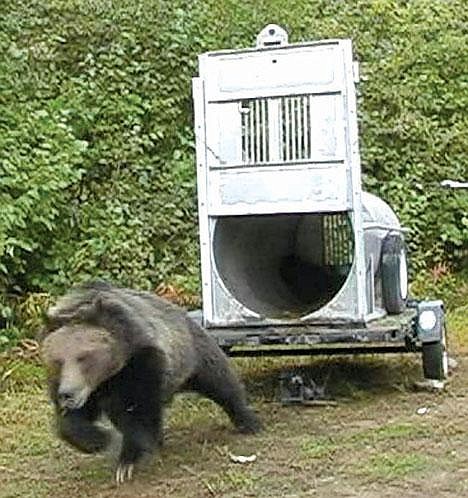Grizzly sow released in West Cabinets
By STEVE KADEL Western News Reporter
After spending two days in a metal culvert trap, the female grizzly bear named Eve was getting restless.
She was captured Friday on the North Fork of the Flathead River, lured into the trap by the smell of a roadkill deer. By Sunday afternoon, a caravan of wildlife officials had trucked Eve through Libby and up a potholed U.S. Forest Service road high into the western Cabinet Mountains.
Federal and state biologists, media, and a few other curious bear watchers milled about as elaborate precautions were taken to release the first grizzly into the Cabinets in more than 10 years.
Eve was certainly ready. She snorted and woofed inside the metal tube. She let out long, low growls so deep they seemed to come from deep inside her chest rather than her throat. Once she banged a paw at the trap's metal bars, showing claws several inches long. The oblong trap, anchored by rocks around its wheels, shook with her movements.
"You're all right, you're all right," Derek Reich said in a soothing voice as he positioned a camera near the trap's door.
Reich's wife Heather contracted with Fish, Wildlife and Parks to bait and monitor grizzly traps in the Whitefish Range. The Utah couple called Fish, Wildlife and Parks representatives to report the catch on Friday, and agency personnel darted the bear and took measurements.
Now Derek was photographing the release from several angles, with cameras mounted on tri-pods along Eve's likely escape route.
When Reich was all set up, state grizzly bear management specialist Tim Manley went to the trap's door to check on his pulley rope system. He would sit in the cab of the truck carrying the trap and pull the rope, freeing Eve in the vicinity of Spar Lake.
"I think she's finally mellowed," Manley said to people standing behind him. "She's sitting in the middle of the trap with her head down."
Everyone took their places. Some got inside pickup trucks and held canisters of pepper spray. Others watched from inside the Reichs' RV. Photographers perched atop the RV roof and poised their cameras on the trap. A rifle with rubber bullets was ready just in case something went wrong.
But nothing did.
Eve pawed at the door as it went up, stuck her head out and looked briefly to the left. Then she bolted from the container and ran down a narrow jeep trail. Fifty yards from the trucks she veered into some underbrush and bounded downhill. It all happened in five seconds.
Wayne Kasworm, the U.S. Fish and Wildlife Service's chief local bear biologist, said the relocation site was chosen because grizzlies have not been monitored on the west side of the Cabinets as much as elsewhere in the range. If Eve stays on the west side, it could give biologists new data about the area and grizzlies' activities there, he said.
The Reichs were hired to trap grizzlies in the Whitefish Range, where they are relatively plentiful, for other state studies in the Northern Continental Divide Ecosystem. Kasworm had a standing request that if the right bear was trapped, he wanted it to help supplement the low Cabinet grizzly numbers.
Eve was a perfect candidate. She's estimated to be about 275 pounds, is healthy, and most importantly has not been collared or had known encounters with humans. Kasworm's priority was a bear with no human history.
There's a chance Eve is pregnant, he said, although that won't be known for sure until she emerges from her den next spring. The bear was fitted with a radio collar and Kasworm will fly twice a week to monitor her whereabouts until denning occurs.
Biologists hope that den is in the West Cabinets, although there's a chance she might try to get back to her former home range. State Fish, Wildlife and Parks biologist Jerry Brown, who has long experience with bears, is confident Eve will stick around.
"She'll figure it out," he said. "If she heads east, she's got the main part of the Cabinets to cross."
Kasworm said a grizzly hasn't been released in the Cabinets since 1994. A grizzly was released in 1993, too, and Kasworm said hair snag samples taken last year indicate that animal is still in the Cabinets.
He estimates there are 15 grizzlies in the Cabinets now, and another 20 to 30 in the Yaak. The recovery goals is for 100 grizzlies in the combined 2,600 square miles of the Yaak and Cabinets.
Up to two or three bears could be relocated in the area annually, if the right type of bears are found.
Mike Balboni, head ranger for the Three Rivers Ranger District where Eve was released, said the district is entirely classified a grizzly recovery zone. Relocating more bears won't cause additional Forest Service road closures, he said.
"This isn't going to change anything as far as how we manage," Balboni added.
He chose the name "Eve" because it is the first grizzly released in the West Cabinets.
Heather Reich, who met her husband while working on a project to reduce interactions between grizzlies and humans, bustled around the release site on Sunday like an excited child on Christmas morning. She and Derek have committed themselves to helping increase grizzly populations, and live out of their RV each year during field work. Heather's engagement ring even has a bearpaw insignia, as do the ear rings she wore Sunday.
She smiled happily minutes after Eve scooted into the woods to begin life in a new home.
"She's a tough little bear," Heather said. "She'll be OK here."

